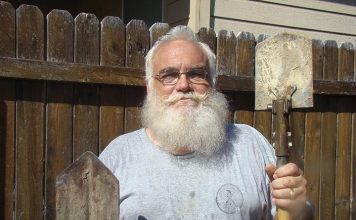| Issue #64 • July/August, 2000 |

Hydronic, or radiant floor heating is a method of heating a home, shop, or other building with the heat concentrated in the floor. It works by embedding special tubing in a concrete foundation or in a thin concrete mixture on top of a wood-framed floor. Heated water (or a food-grade antifreeze mixture) flows through this tubing, warming the thermal mass of the concrete.
Conventional forced-air systems, wood stoves, or other heating methods produce uneven heat, with the highest air temperatures near the ceilings. Hydronic heating puts the heat in the floor under your feet, gently warming a room or a complete structure. This results in similar heating levels with superior comfort without wasting energy and money in monthly fuel bills. The warm water circulated through the tubing in a radiant floor may come from solar collectors, water heaters, demand water heaters, wood stoves, or heat pumps.
I asked Stephen Heckeroth to describe the technology, design issues, and construction and installation techniques related to hydronic heating in general, and heating radiant floors with solar collectors specifically.
MH: I first heard of running heated water through tubing in the floor a few decades ago. I think I heard about the ones that didn’t work. Copper tubing that leaked or corroded. Water that froze and cracked the concrete. What’s the situation today? What kind of tubing have you used?
 Above: Forced-air heating versus the ideal warming curve for a person.Below: Radiant floor heating is a good match for human comfort.  |
Stephen: The technology, materials, and techniques have come a long way in the past decades. I use PEX tubing from Wirsbo. It is specifically designed to withstand the rigors of being embedded in concrete and exposed to water at high or low temperatures. It’s available in a variety of diameters 3/8-inch, ½-inch, 5/8-inch, ¾-inch and 1-inch. The 5/8-inch diameter tubing is popular because it offers a good balance between cost and pressure drop. The ¾-inch and 1-inch tubing are relatively expensive. The 3/8-inch and ½-inch offer too much resistance, which means more energy consumption to pump the liquid through the pipe. The 5/8-inch tubing is the minimum size needed for thermosiphon. The tubing comes in 300-foot and 1000-foot rolls.
MH: We should explain that thermosiphon is a natural flow of water. It is a result of water being heated and allowed to rise convectively as part of a circulation plan in a closed-loop system. For example, water heated in a solar collector will naturally want to rise, effectively both pushing and pulling at cooler water in a circulation pattern. It’s a low-tech way to move heat from a collector to storage and use.
Stephen, will you describe the layout pattern for the tubing?
Stephen: The PEX tubing is laid in patterns called zones in the pad area to be poured with concrete. A zone might be one room. A larger room might need two zones. These zones terminate in a header pipe that is connected to the source of heated fluid. The length of the zone determines the diameter of the tubing. A small zone of 3/8-inch tubing will need the same pump effort as 5/8-inch tubing of a longer length. Since there is resistance in any tubing, 280 feet is the largest distance recommended by the manufacturer for 5/8-inch tubing.
The tubing is laid out in an exaggerated S-pattern, with many variations. It may be as tight as six inches on center (distance apart) or up to 1½ feet apart. A 12-inch on center pattern is common. The zones should be placed wherever there is foot traffic. Position tubing in front of the toilet, near the tub, and in front of the sink in the bathroom. Use the same strategy for the stove, the kitchen sink, and around the dining table. If you’re working from a detailed plan, avoid areas like under cabinets or in closets. Increase the spacing of the tubing to 1½ feet apart in areas that are less traveled. The average size of a zone is about 250-400 sq. ft.
Wirsbo has created a manual (CDAM, 185 pages, $5 from Wirsbo) that lays out additional patterns that address specific issues or preferences. The manual is extremely useful for understanding the hardware, issues, layouts, options, and methods of heating from virtually any energy source in any climate. In Western Europe, 50% of all new construction uses radiant floor heating systems.
MH: Is there any difference in strategy with a system that will depend on solar versus one that is dependent on propane or wood heat?
Stephen: Generally, yes. With solar heating, you’re counting on the concrete to act as thermal mass. Slow to heat, slow to cool. With propane heating, the mass isn’t really necessary. The thinner slab, maybe as little as 2 inches thick on an existing floor, will heat faster than a big slab but it won’t hold the heat long.
MH: Is this garden-variety concrete you’re talking about?
Stephen: Yes and no. Regular concrete works for thick slabs (4 inches plus) and solar-assisted heating. For thin slabs, use Gypcrete and Flowcrete. They’re like concrete but not as hard. Using them doesn’t result in a finished floor. You must finish the floor with tile, linoleum, or some other cover.
MH: Radiant-floor heating seems a perfect application for solar heating. In your experience, is this true?
 The layout of radiant floor tubing in the slab. |
Stephen: If you’re investing in a concrete foundation and slab, it makes sense to have it work for you in another way, as thermal mass. A thin layer of insulation under a concrete slab will serve to keep the ground from acting as a heat sink. At the same time, the ground serves to help regulate the slab temperature because any extreme will be tempered by the earth’s relatively constant temperature.
For solar heating, you will want a 4-6 inch thick slab. It will take a long time to change the temperature of that much thermal mass and its earth connection. It will tend to be cool in summer and vertically-mounted solar collectors will keep it warm in winter.
MH: Can you give me a ballpark figure for cost of the Wirsbo tubing?
Stephen: Retail, a 1000-foot roll of ½-inch tubing is about 70 cents a foot. It’s about 80 cents a foot for 5/8-inch tubing. The tubing comes with or without an oxygen barrier. I prefer the non-barrier because it is less expensive and I’m careful not to use fittings that will oxidize. A system designed to use solar-heated water that circulates by thermosiphon is susceptible to blockage by air bubbles. It’s hard to avoid them where the tubing lies so flat or may have high spots. Bubbles in the water accumulate in the smallest high spots, finally blocking the flow. A small in-line centrifugal pump, 1/20th of a HP in rating, can be used for purging. It will circulate water through the tubing fast enough to dislodge an air bubble. The purge pump only comes on when the system stagnates and the collectors overheat. When circulation is restored, the pump shuts off.
How do you know when a bubble blocks a thermosiphon flow? Install temperature sensors at various points in the system and connect them to a differential control. Use the kind of sensor that fits in a tee off the plumbing and accepts a probe from a digital meter. When the difference in temperature between two points, i.e., at the top of the collector and at some point in the concrete, reaches a preset value, it will run the purge pump until the thermosiphon flow is restored.
 A typical layout for radiant heat tubing in the floor of a room. |
MH: In one hydronic heating installation I saw ball-cock valves on each tube that led away from the manifold to a zone. Presumably, this gave the owner control of the individual zones, which room was heated, which was not. How well do these work in a solar-heated system?
Stephen: I don’t use zones in a solar-heated system. There may be many loops but the whole floor is treated as one zone. The system is always on. With vertically-mounted collectors, the floor is heated by the sun through three seasons and cooled to earth temperature in the summer. The thermal mass is a huge thermal flywheel. You dump heat into it in the winter and take it out in summer.
MH: Does this system also handle domestic hot water for showers, dishwater, and laundry?
Stephen: Solar panels for a radiant-floor heating system are angled to intercept the rays of the winter sun, which sits 20-35 degrees above the southern horizon at noon. Domestic hot water usage must be angled to optimize heat gain year-round, so the collector must be pointed toward a mid-point, roughly 45-60 degrees above the horizon in the continental USA. Of course, these collectors circulate this water through a storage tank for later use. In the McMillan house, additional collectors were added at the west end of the building and tilted to utilize summer sun for domestic hot water.
MH: What other plumbing is needed for the radiant floor system?
 The McMillan foundation is inlaid with insulation and tubing and checked for leaks prior to pouring the slab. |
Stephen: I’ve already mentioned the in-line pump which is used primarily for purging the system of air bubbles. It must be centrifugal or the water will not flow through it during thermosiphon. An air-bleeder valve is needed, as is an expansion tank and purge valves. This is standard equipment.
MH: Will you describe the requirements of the insulation under a concrete slab that will act as thermal mass?
Stephen: The insulation works only as a thermal break. It shouldn’t have a very high R-value because we want the slab to act as a heat sink in summer. I used foil-faced bubble wrap material which is made specifically for under-slab use. It doubles as a thermal break and radiant barrier. And it’s inexpensive. Rigid foam, like foil-faced technifoam or blueboard, also works. Around here, the ground under a slab remains at a constant 58 degrees F. Further north, the ground temperature is colder and more insulation is required. Further south, little or no insulation is required. Carlsbad Caverns stays at a constant 70 degrees F. while the surface temperature outside varies between zero and 115 degrees F.
MH: Can you describe the site preparation for pouring the foundation for a radiant floor?
Stephen: The overall depth of the “floor” is about 8 inches thick. The process?
- Cover the excavation with two inches of dry sand. The ground will tend to be damp so it must be dried up, and then covered evenly with sand.
- Lay in one inch of foam or ¼-inch bubble wrap. Don’t scrimp; it’s cheap.
- Spread dry sand over the insulation to hold the insulation in place and to keep bubbles from rising up through the poured concrete and spoiling the finish.
- Add the wire mesh. I use 6-6-10-10 wire. This is #10 wire in both directions, 6 inches on center. Bending back the corners will tend to flatten the wire perfectly.
- Lay out the pattern of radiant tubing and tie it to the mesh. Run the tubing from each zone up into the manifold. The manifold is a pipe header, ¾-inch to 1-inch in diameter and made of brass, with tees to accept the tubing.
- Pour the concrete. This should be 4-6 inches deep.
MH: Will you describe the radiant floor system of the McMillan house?
Stephen: The McMillan house has a total of eight loops. The house is open plan, so there are four loops in the great room (kitchen, dining area, living room), two in a family/guest room, and one each for the two upstair bathrooms. The design called for direct solar gain on the south-facing side, solar thermosiphon to a back-up propane tank on the east end, and direct thermosiphon with a purge pump on the west end. Propane is the backup heating source.
|
A direct-vent, 80-gallon propane water tank is used on the east end with a simple timer. The timer won’t heat water for the floor until afternoon, giving solar energy a chance to heat the system. If it hasn’t, the timer engages the fan on the propane water tank which, in the unit I use, will permit the heater to switch on. A small pump circulates water through a heat-exchanger in the tank and then through the radiant floor tubing.
I like to minimize controls in systems because they don’t last, and the system performs erratically or fails. I will use differential temperature sensors. When the floor is cooler than the water in the tank, the pump turns on. This pump motor draws 80-watts.
MH: We haven’t talked about solar-thermal panels yet.
Stephen: The solar-water-heating collectors in this installation are mounted vertically against the south-facing outside wall. This maximizes the winter heat gain and impedes any significant heating effect in summer. There are many brands available, new and used.
The panels in the McMillan house came used from Triple A Solar in New Mexico. They have 1-inch diameter headers and ½-inch risers in a 10-foot by 4-foot, bronze-iodized aluminum case, 5 inches thick. The riser tubes and fins are black-chromed copper to capture and channel the heat converted from sunlight. The only plumbing requirement is to use only similar metals in all parts to avoid premature corrosion. The collector’s glazing is tempered glass, with a roughened surface to minimize reflection.
MH: I understand there are quite a few used solar water-heating modules out there. When tax rebates and write-off legislation spurred a boom in the solar water-heating industry a few decades back, a lot of different companies got involved. Earlier, you mentioned designing a system with few controls. A major failing of the industry years ago was the control system. It was too complicated, too varied, too prone to malfunction. On the other hand, many of the collector designs of that period were solid. It was some other part of the system that failed, not the collector. These systems are still being stripped from buildings or replaced by newer designs.
Stephen: Used water-heating collectors are widely available. Used collectors from Triple A Solar were $150 each. New, these collectors would be over $500 each. Panels that have been removed from a system may prove to be a good investment. A simple pressure check will find any leaks.
MH: Let’s talk about freezing climates, solar water-heating modules, and radiant floor heating systems. The danger in any solar water-heating system is that water may freeze in the collector and burst a pipe. At the least, a mess. Certainly inconvenient. Likely expensive. This is a challenge in solar collectors in systems for domestic water heating. What about solar collectors for radiant floor heating systems?
 A radiant floor system using a water heater as an energy source |
Stephen: There are two ways to approach this problem in cold climates or warm climates that get an occasional freeze. The first uses ordinary tap water and relies upon a thermal-bleed valve, or Dole valve. This valve is designed to start dripping when the water at the valve drops to a preset temperature, either 38°F or 43°F. Moving water freezes at a much lower temperature than water which is stationary. A drip valve acts like a leak in the system, letting water out, bringing in new water warmed from the slab or tank. As it gets colder, the Dole valve drips even more. I’ve found the Dole valve to be reliable on the northern California coast where freezing temperatures are rare. It needs to be checked and cleaned annually, but it is perfect for a mild climate.
The other technique to avoid freezing the collector is to add polypropolene glycol to the water. This is a food-grade anti-freeze used as a dough extender in the baking industry. It’s about $10 a gallon but you don’t need much. A 10% solution will protect the collectors down to 20-25 degrees F. Use a higher percentage for correspondingly lower temperatures.
MH: Stephen, thank you for taking the time to share your experiences with BHM’s readers. Any closing thoughts?
Stephen: Orientation is 80% of solar design. Good orientation means choosing a building site with unobstructed solar access, making maximum use of the south-facing roof and walls, and using a lot of insulation in the north walls and roof. The south-facing roof is the place for solar-electric modules and collectors for domestic hot water.
Most of the window area (7-10% of the building’s floor area) should be located on the south-facing walls for daylighting and direct solar gain in winter. The building plan should be designed to accommodate vertically-mounted solar collectors for radiant-floor heating here, too. Add overhangs to thwart solar gain in the summer. The north and west walls should have minimum window area, less than 2% of the floor area for north windows to avoid heat loss and west windows to avoid afternoon overheating. The east wall should have windows of 4-6% of the floor area for early morning warmup.
The ideal building site slopes down to the south, increasing solar exposure and facilitating convection and thermosiphon loops. The north side of the building should be dug into the slope to prevent heat loss and increase the earth connection. In my experience, the owners of a well-designed solar home will pay little or nothing for electricity or heat for the life of the building.
(Stephen Heckeroth, Homestead Enterprises, P. O. Box 410, Albion, CA 95410. Phone/Fax: 707-937-0338. Website: www.renewables.com
Wirsbo USA, 5925 148th St., Apple Valley, MN 55124. Phone: 306-721-2449; Fax: 306-721-3088. Website: www.wirsbo.com)















